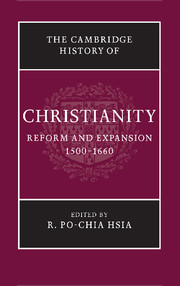Book contents
- Frontmatter
- Part I Luther and the Holy Roman Empire
- Part II The Second Reformation
- Part III Catholic Renewal
- Part IV Resolving Confessional Conflicts
- 13 Peace without concord: religious toleration in theory and practice
- 14 Imposing church and social discipline
- 15 Persecutions and martyrdom
- 16 The Mediterranean Inquisitions of early modern Europe
- 17 Religious colloquies and toleration
- 18 Western Christianity and Eastern Orthodoxy
- Part V Religion, Society, and Culture
- Part VI Christianity and Other Faiths
- Bibliography
- Index
- References
18 - Western Christianity and Eastern Orthodoxy
from Part IV - Resolving Confessional Conflicts
Published online by Cambridge University Press: 28 March 2008
- Frontmatter
- Part I Luther and the Holy Roman Empire
- Part II The Second Reformation
- Part III Catholic Renewal
- Part IV Resolving Confessional Conflicts
- 13 Peace without concord: religious toleration in theory and practice
- 14 Imposing church and social discipline
- 15 Persecutions and martyrdom
- 16 The Mediterranean Inquisitions of early modern Europe
- 17 Religious colloquies and toleration
- 18 Western Christianity and Eastern Orthodoxy
- Part V Religion, Society, and Culture
- Part VI Christianity and Other Faiths
- Bibliography
- Index
- References
Summary
Throughout the Middle Ages, the relationships between Western and Eastern Christianity were characterized by two tendencies. On the one hand, there was estrangement, while on the other hand, there were the links between Rome and the Eastern churches, as well as between Catholics and Orthodox people in all European countries, that were never interrupted and sometimes even intensified. Both tendencies were reflected in the history of the Florentine Union (1438–9), which was the last attempt in the Middle Ages to overcome the estrangement. However, the rejection of the Florentine Union in Orthodox societies showed that the development of confessional self-consciousness both in the West and in the East had increased the distance between the two churches and their cultures. Were these growing tendencies towards estrangement replaced by others between 1500 and 1660? There are numerous studies of the subject: the main points of contact between Western and Eastern Christianity in the sixteenth and early seventeenth centuries are more or less clearly described, although there remains much that has not been studied or is open to dispute. This chapter provides a brief overview of how the relations between Rome and the Orthodox East developed in this period, how the dialogue between Catholicism and Orthodoxy in Eastern Europe and in the Balkans continued, traces the relationship between Protestants and the Orthodox, and studies the interaction between Eastern and Western Christianity in the ‘epoch of confessions’.
- Type
- Chapter
- Information
- The Cambridge History of Christianity , pp. 321 - 342Publisher: Cambridge University PressPrint publication year: 2007
References
- 2
- Cited by



